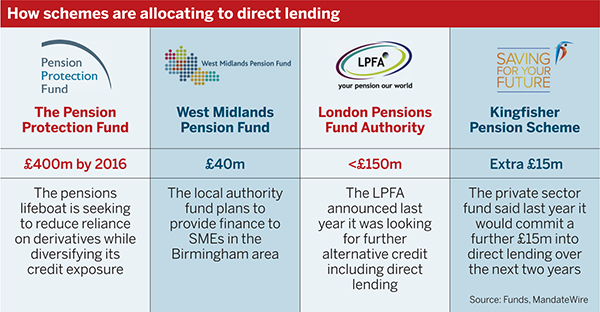Leicestershire Pension Fund plans to moves its entire credit portfolio into direct lending as it makes a further £100m investment in an asset class increasingly targeted by yield-starved pension funds.
Direct lending has become more popular in recent years as tighter regulation on banks following the financial crisis has discouraged many from giving loans to certain sectors, opening up the space for institutional investors.
 The local authority fund has so far made £48m of loans through a direct lending fund run by asset manager M&G Investments. Around £4m worth of those have since matured.
The local authority fund has so far made £48m of loans through a direct lending fund run by asset manager M&G Investments. Around £4m worth of those have since matured.
Last year the fund made a £100m allocation to a Partners Group global direct lending fund, of which around half has been drawn down so far.The fund is currently invested in a global credit portfolio managed by JPMorgan, but Colin Pratt, investments manager at the Leicestershire fund, said this would eventually be replaced by direct lending.
He said: “In the fullness of time we would expect our entire allocation to credit will be in direct lending.” This allocation currently makes up 5 per cent of the fund’s £2.7bn assets.
Phil Irvine, director at investment consultancy PiRho, said direct lending had been growing since 2008. In the past year the Pension Protection Fund, West Midlands Pension Fund, London Pensions Fund Authority and Kingfisher Pension Scheme have all announced or increased allocations to the asset class.
“Because of the aftermath of 2008 where regulators decided to restrict banks’ ability to deploy leverage, it’s created an opportunity for other lenders to step in,” said Irvine. “What the financial markets are doing is trying to step in at a time when government bond yields look low.”
He added: “Typically, loans are linked into short-term interest rates [so] you don’t get that risk.”
Government gilt yields fell to fresh lows last week, with Switzerland’s 10-year bond yield going negative. Commentators said this was probably the first time in history that a government bond of that duration had done so.
Greg Fedorenko, associate at investment consultancy Redington, said pension schemes could find greater returns in direct lending than on the syndicated loan market. He also said the greater degree of control over covenants in a direct loan led to higher recovery rates than in syndicated loans.
He added: “Direct lending is often considered by schemes looking to take greater illiquidity risk in their portfolio as an alternative to reliance on the stock market to generate returns, while seeking the greater certainty inherent in investing in credit instruments… possessing attractive, contractual cashflows.”
Alongside the risks associated with illiquidity, Fedorenko said the lack of transparency was one of the main drawbacks with the asset class.
He added: “Given the fact that many corporates seeking financing from direct lending managers are owned by private equity sponsors, deal flow is indirectly reliant on the ongoing vitality of the leveraged buyout market.”
Danny Vassiliades, who is chief executive of Punter Southall’s investment consultancy arm, said direct lending offered attractive returns, provided schemes were mindful of diversification and transparency.
“It allows you to access a part of the market where the investment premia is higher than government bonds [but] you have to know what the criteria is for the lending,” he said.














